Every homeowner knows that a dry basement is a happy basement. However, unnoticed or untreated, a small leak can rapidly escalate into a significant problem, wreaking havoc on your home and potentially leading to expensive repairs. Early detection is the key to averting such complications. By recognizing and addressing the initial signs of a leak in the basement, you can protect your property and pocket.
From visible puddles to more discreet indicators like an unusual musty odor, understanding these common signs is the first step in safeguarding your basement.
Identifying a Leak in the Basement
Basements, the sturdy foundations of our homes, can sometimes reveal subtle distress signals. From the alarming sight of pooled water to the incessant operation of your sump pump, various signs might indicate a lurking issue.
Visible Water
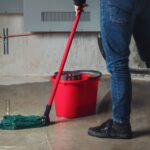 One of the most evident signs of a potential leak is the actual presence of water in your basement. This manifestation can range from:
One of the most evident signs of a potential leak is the actual presence of water in your basement. This manifestation can range from:
When you spot puddles or areas of standing water, it’s a clear red flag. These pools indicate an active leak, possibly resulting from external hydrostatic pressure, compromised drainage systems, or even foundation cracks. Ignoring these pools can lead to greater structural damage, so immediate action is essential.
Even if there isn’t visible pooling, the presence of damp or wet spots on the walls or ceiling of your basement shouldn’t be overlooked. These moist areas can be early warning signs, hinting at possible water seepage from the ground or leaks from overhead pipes. Over time, these damp areas can lead to mold growth or further degradation of building materials.
Musty Odor
Even if you can’t see a problem, sometimes you can smell it. Basements can develop a distinct aroma over time, and it’s crucial to understand its root cause.
A persistent musty smell often indicates trapped moisture. Whether it’s due to inadequate ventilation or underlying leaks, this odor is a sensory red flag for prolonged dampness. Even in the absence of visible water, that characteristic musty scent serves as a warning that moisture is accumulating somewhere it shouldn’t be.
Moist environments are breeding grounds for mold and mildew. While the musty smell alone is unpleasant, it could also be signaling the growth of mold in hidden corners, behind walls, or under floor coverings.
Spotting Stains or Discoloration
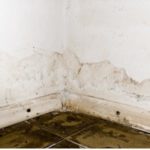 Stains and discolorations on your basement walls, floors, or ceilings can be revealing indicators of a leak in the basement. Recognizing and understanding these marks is essential for timely intervention.
Stains and discolorations on your basement walls, floors, or ceilings can be revealing indicators of a leak in the basement. Recognizing and understanding these marks is essential for timely intervention.
Water stains typically present as darkened, damp-looking patches or streaks. They might be a darker shade than the surrounding area and can often feel cold or wet to the touch. They’re most commonly seen on walls and ceilings, following the path water takes as it seeps or runs down. On concrete or tiled floors, these stains might manifest as darker spots or rings.
While both can cause stains, ongoing and past leaks can sometimes be differentiated. Fresh, damp patches that might grow in size or become more pronounced during rain suggest an active leak. On the other hand, dry, stable stains that don’t change in appearance could point towards a past leak that may have been addressed.
Even if you suspect the leak is a thing of the past, it’s essential to monitor the area for any changes and ensure no residual moisture.
Peeling Paint and Wallpaper
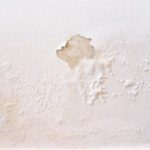 A beautifully painted or wallpapered basement can lose its charm when faced with a leak in the basement. Recognizing the impact of water intrusion on these finishes is pivotal, enabling homeowners to act swiftly.
A beautifully painted or wallpapered basement can lose its charm when faced with a leak in the basement. Recognizing the impact of water intrusion on these finishes is pivotal, enabling homeowners to act swiftly.
When moisture seeps into your basement walls, it doesn’t stay confined to the inner layers. As it moves towards the surface, it can cause the paint to lose its adhesion, leading to bubbling, cracking, or peeling. Wallpaper isn’t immune either. Moisture can weaken the adhesive used to bond the wallpaper to the wall, causing it to loosen, bubble, or peel away entirely. In extreme cases, you might even notice discoloration or mold growth behind the peeling layers.
While moisture can affect any part of your basement, there are specific zones more prone to these woes. Start by inspecting areas closest to ground level, corners, around window frames, and near any visible cracks. These are typical entry points for water.
Also, don’t forget to check behind furniture, storage units, or any other items placed against the walls, as these can trap moisture and exacerbate the damage.
Efflorescence
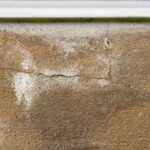 A peculiar white, chalky substance that sometimes appears on concrete and brick surfaces, efflorescence is more than just a cosmetic concern. It provides crucial insights into the moisture history of your basement.
A peculiar white, chalky substance that sometimes appears on concrete and brick surfaces, efflorescence is more than just a cosmetic concern. It provides crucial insights into the moisture history of your basement.
Efflorescence is a mineral deposit left behind when water seeps through masonry or concrete and then evaporates from the surface. As the water moves through the material, it dissolves naturally occurring salts. When this moisture reaches the surface and evaporates, it leaves the salts behind, manifesting as a white, powdery residue.
While efflorescence doesn’t harm the structural integrity of the concrete or masonry, its mere presence signals that water has infiltrated the material at some point. Even if the basement appears dry now, efflorescence suggests that there has been a moisture problem in the past.
Addressing the root cause of a leak in the basement is crucial. Failing to tackle the source of moisture intrusion can lead to repeated wet conditions, potentially escalating to more severe issues.
Cracks in the Basement
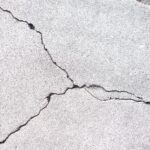 The sight of cracks in your basement, whether minor hairline fissures or more pronounced splits, can be unsettling. These disruptions are more than just aesthetic issues; they can act as gateways for unwanted moisture.
The sight of cracks in your basement, whether minor hairline fissures or more pronounced splits, can be unsettling. These disruptions are more than just aesthetic issues; they can act as gateways for unwanted moisture.
Concrete, by its very nature, is a porous material. When cracks form, they create easy paths for water to infiltrate. Depending on their location and the external water pressure, even small cracks can become channels for significant water ingress, especially during heavy rains or when snow melts. It’s essential to realize that what might seem like a minor crack on the surface could be a symptom of a deeper, unseen issue.
Regularly inspecting your basement is crucial. Look for any new cracks or note if existing ones seem to be widening. Using a pencil, you can mark the ends of the crack and date it. This way, on subsequent checks, you can easily tell if the crack is expanding.
Also, pay attention to the direction of the crack. While vertical cracks are often due to settling and may not be as concerning, horizontal cracks can indicate more severe issues, such as external pressure on the foundation. Any sudden or significant changes in the size, number, or type of cracks warrant immediate professional attention.
Condensation
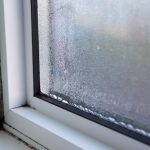 Condensation in the basement is a common issue, often overlooked or mistaken as a minor inconvenience. However, it’s essential to understand that persistent condensation can lead to bigger problems in the long run.
Condensation in the basement is a common issue, often overlooked or mistaken as a minor inconvenience. However, it’s essential to understand that persistent condensation can lead to bigger problems in the long run.
Condensation happens when warm, moist air comes into contact with a cooler surface. In basements, these cooler surfaces include walls, floors, pipes, windows, and other metallic surfaces. It’s common to find droplets of water forming on these colder surfaces, especially after a sudden temperature drop or during humid months.
Basements are naturally prone to higher humidity levels due to their underground location. Various factors like poor ventilation, lack of insulation, or the mere absence of regular human activity can cause the moisture level to rise. When the humidity in the air becomes too high, it can no longer hold onto all the moisture, leading to condensation.
It’s essential to manage and control basement humidity levels, not just for comfort but for the health and safety of the entire household. Consider using dehumidifiers, improving ventilation, or seeking expert advice on comprehensive moisture control solutions.
Mold or Mildew Growth
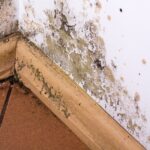 Mold and mildew are not only unsightly but can also pose health risks to the inhabitants of a home. Their presence in a basement often indicates underlying moisture problems that need to be addressed immediately.
Mold and mildew are not only unsightly but can also pose health risks to the inhabitants of a home. Their presence in a basement often indicates underlying moisture problems that need to be addressed immediately.
Mold typically appears as black, green, or even white patches that grow and spread on organic surfaces. Common areas in the basement where mold can take hold include wooden beams, drywall, carpets, and even cardboard boxes stored for long periods. Mildew, on the other hand, usually presents as a powdery white or gray substance on the surface of materials. Frequently checking areas that are out of sight, like behind furniture or stored items, is essential to catch mold growth early.
Mold and mildew thrive in damp conditions. Their presence is a blatant indicator that your basement has a consistent source of moisture. Whether it’s from leaks, condensation, or exterior water infiltration, these fungi will only grow and multiply if the moisture problem persists.
In addition to being health hazards, mold and mildew can damage the materials they grow on, leading to decay and structural problems over time. Addressing the root cause of the moisture and cleaning or removing affected materials is critical in preventing further mold growth and ensuring a healthy living environment. If you suspect a large mold outbreak or have respiratory issues, it’s essential to consult professionals for safe removal.
Sump Pump Running Frequently
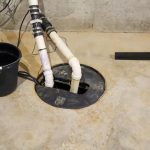 A sump pump plays a vital role in keeping basements dry, especially in areas prone to groundwater accumulation or flooding. However, just like any machine, its continuous operation might be a signal of underlying problems.
A sump pump plays a vital role in keeping basements dry, especially in areas prone to groundwater accumulation or flooding. However, just like any machine, its continuous operation might be a signal of underlying problems.
A well-functioning sump pump will operate intermittently, particularly during heavy rains or when there’s a significant amount of water to be drained. On the other hand, if you notice that your sump pump is running constantly or switching on and off too frequently even in dry conditions, it might be overworking.
Continuous sump pump operation can hint at various issues. It might be a sign that the pump isn’t correctly sized for your home – either too small to handle the volume of water or too large, causing it to run inefficiently. There might also be a problem with the installation or the positioning of the pump. Frequent operation can also suggest that there’s a consistent source of water entering your basement, which might be due to cracks in the foundation, poor drainage systems, or a high water table in your area.
It’s essential not to ignore an overworking sump pump. Continuous operation not only wears the pump out faster, leading to potential equipment failure when you need it the most, but it can also inflate energy costs and indicate more severe basement water issues. If you’re concerned about your sump pump’s activity, consult a professional to assess the situation and recommend solutions.
Why Your Basement Leaks in Heavy Rain and How to Prevent It
Heavy rain poses a significant risk for basement leaks, and understanding the causes is key to prevention. When drainage systems are inadequate or clogged, rainwater tends to pool around the foundation, potentially causing leaks. Additionally, rainwater may find its way through existing cracks or gaps in the foundation.
During periods of heavy rain, the groundwater level can rise, creating hydrostatic pressure against the basement walls. This pressure can force water into your basement. Moreover, sump pumps that are overwhelmed or not functioning properly may fail to effectively remove this excess water, exacerbating the issue. Taking steps to address these vulnerabilities can help in keeping your basement dry during heavy downpours.
Preventive Measures:
- Improve Drainage
- Clean gutters and downspouts regularly to prevent blockages.
- Extend downspouts at least 4-6 feet away from the foundation.
- Ensure the land around your home slopes away from the foundation to prevent water pooling.
- Consider installing French drains or catch basins if you have persistent drainage issues.
- Repair Cracks
- Regularly inspect your basement walls and floors for cracks.
- Use appropriate sealants or injections to repair minor cracks.
- For larger cracks or if you’re unsure of the severity, consult a professional.
- Address exterior foundation cracks as well, as they can lead to water seepage.
- Install or Upgrade Sump Pump
- Ensure your home has a properly functioning sump pump.
- Consider a sump pump with higher capacity if you live in an area with heavy rainfall.
- Install a battery backup system to keep the sump pump running during power outages.
- For added protection, consider a secondary, backup sump pump.
- Regular Maintenance
- Schedule routine inspections of your basement’s waterproofing system.
- Test your sump pump regularly by pouring water into the pit to make sure it activates and drains quickly.
- Check and clean the sump pit from any debris that could obstruct the pump.
- Inspect and maintain other basement waterproofing systems like interior weeping tiles or exterior membranes.
Implementing these preventive measures can significantly reduce the risk of basement leaks during heavy rain, safeguarding your home’s foundation and interior from water damage.
Early Detection of a Leak in the Basement
Basement leaks, regardless of their size or seeming insignificance, can pave the way for a cascade of home issues, from structural damage to health hazards. Detecting and addressing these leaks early is not just about preserving the aesthetics of your space, but more crucially, it’s about safeguarding the integrity, safety, and value of your entire home.
Every sign, whether it’s the subtlest musty odor or an evident pool of water, is a cry for attention. Ignoring these signs or procrastinating their resolution can lead to escalated repair costs and extensive damage in the long run.
For homeowners, taking the first step involves recognizing these signs and understanding their potential implications. But it’s equally, if not more, important to follow through by consulting professionals who can provide expert evaluations and solutions. Their expertise will ensure that the leaks are not just temporarily patched but thoroughly addressed, guaranteeing peace of mind and a dry, safe living environment for years to come.
Is your basement prepared for the unexpected? With Crackmasters Basement Waterproofing Systems, secure a dry, safe future for your home’s foundation. Schedule your professional consultation with Crackmasters
Recent Posts
Ready to Sell? Common Basement Issues to Fix Before Listing
Preparing to sell your home involves more than just staging the living spaces and enhancing
Steps for a Comprehensive Basement Health Audit
Often overlooked, a healthy basement is a vital contributor to a safe and comfortable home
Common Causes of Foundation Leaks
Maintaining a dry basement is crucial not only for comfort but also as a fundamental

